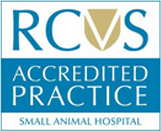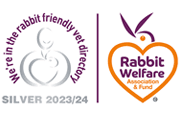Cranial Cruciate Ligament Disease
Cruciate ligament rupture is a common and debilitating knee injury in dogs.
There are a large number of different surgical techniques described to manage CCL disease. They can however be grouped into 2 broad categories
- Surgery to mimic the action of the CCL. In our practice we will normally place a nylon ligament between a tunnel in the top of the shinbone and the fabella. This procedure is usually very successful but is usually only recommended in small dogs.
- Stabilising the joint by osteotomy techniques that do not rely on the action of cruciate ligament. Of these, TPLO (Tibial plateau levelling osteotomy is the current ‘gold standard’ and recommended treatment option for dogs suffering cruciate ligament disease. Osteotomy means cutting of bone.
Following a CCL tear there is a tendency for the femur to roll backwards down the slope of the shin bone (tibial plateau) when weight is put through the leg. This relative movement between the tibia and femur causes pain.
The TPLO procedure aims to eliminate (or greatly reduce) the angle of this slope by cutting the tibial plateau and ‘levelling it’ by rotating to a pre-measured level. This renders the CCL redundant. The cut bone is then fixed in its new place using a plate and screws.
The TPLO procedure is a more robust procedure than the above-mentioned ligament replacement surgery. The major practical benefit is a very reliable return of limb use, with all dogs expected to start weight bearing on the operated limb within 1-3 days.
Uncomplicated cases of ruptured cranial cruciate ligaments with subsequent TPLO surgery recover well. Some in fact will be walking better when they leave the hospital than when they entered for surgery. Most are walking about 75% normal at the 2-week recheck, and 90-95% normal at the 8-week recheck.
Arthrotomy
We will also explore the knee joint during the surgical procedure to evaluate for possible damage to the menisci (shock absorbing structures within the stifle joint that protect the cartilage).
Potential complications of the surgery include infection, fracture, screw loosening and delayed healing of the cut bone. Meniscal damage is a risk for all dogs that have cruciate ligament tear regardless of the treatment chosen and can occur before, immediately after or several months after surgery.
What happens when the CCL is diseased?
When the CCL is diseased or damaged, abnormal movements in the knee joint occur. This causes the stifle joint to move in a way for which it wasn't designed. This causes pain by placing too much weight and force on other structures in the stifle joint.
The menisci are shock-absorbing structures within the stifle joint that protect the cartilage. These are frequently damaged when the CCL fails.
Arthritis of the knee will also occur secondary to CCL disease. Treatment of this arthritis is important when considering long-term management of the knee joint.
Why do dogs (and cats) get CCL disease?
Trauma to the equivalent ligament in humans is common, where damage most often occurs during some form of sport. The nature of the injury is very different in dogs. Rather than the ligament suddenly breaking due to excessive trauma, it usually degenerates slowly over time, rather like a fraying rope.
This important difference is the primary reason why the treatment options recommended for cruciate ligament injury in dogs are so different from the treatment options recommended for humans.
Why does the CCL degenerate and weaken?
This is a very good question and much research is currently being aimed at resolving this issue. There are some predisposing factors:-
Breed
Certain breeds appear to be predisposed to this disease including the Golden retriever, Labrador retriever, Boxer and West Highland white terrier. There is some evidence that there may be a genetic basis to this in certain breeds.
Conformation
Certain conformations appear predisposed including those with an upright stance and those with marked bowing of the hindlimbs.
Body weight
Body weight also appears to be a risk factor with overweight dogs being overrepresented in those dogs with CCL failure.
How do I know if my dog has ruptured the CCL?
Most dogs that have damaged their CCL will be obviously lame on one of their hindlimbs. Sometimes, if both knees are affected by CCL disease, then lameness is less obvious. These dogs may have difficulty jumping, rising and going up stairs.
To diagnose CCL disease, we will take a thorough history, perform a clinical examination and radiograph (X-ray) the stifle joint. Occasionally joint fluid analysis and further methods of imaging including arthroscopy or magnetic resonance imaging (MRI) may be needed.
What can be done about it?
The vast majority of dogs with CCL failure have ongoing and progressive knee pain and instability. These dogs need surgical intervention to improve their outcome.
Non-surgical management is seldom recommended, except where the risks of a general anaesthetic or surgery are considered excessive (e.g. patients with severe heart disease).
Non-surgical treatments include are weight loss where the patient is overweight, physiotherapy, exercise modification, and medication (anti-inflammatories, tramadol, Cartrophen injections, Nutraquin+).
Dogs greater than 15kg have a very poor chance of becoming clinically normal with non-surgical treatment.
Dogs weighing less than 15kg and cats have a better chance, although improvement usually takes several months and is rarely complete.
What surgery can be done?
There are two surgical categories used to treat CCL disease. One aims to replace the deficient ligament, the other renders the ligament redundant by cutting the shinbone and re-aligning the forces acting on the stifle joint.
Ligament replacement surgery
- There are a number of differing types of surgeries that essentially replace the damaged and diseased CCL. In our practice we will normally place a nylon ligament between a tunnel in the top of the shinbone and the fabella. This procedure is usually very successful but is usually only recommended in small dogs.
Tibial Tuberosity Advancement (TTA)
- The TTA is a surgery where a cut is made in the tibia (shin bone) to allow a change in geometry that renders the CCL redundant. The basic principle of this procedure is that by changing the direction of the force from the quadriceps muscle we are able to produce a force across the knee joint that neutralizes the tendency for the femur to roll down the slope of the shin bone. In the procedure a bone plate, a cage and titanium screws are inserted into the shinbone.
- The TTA procedure is a more robust procedure than the above-mentioned ligament replacement surgery. The major practical benefit is a very reliable return of limb use, with all dogs expected to start weight bearing on the operated limb within 1-3 days. The combination of a fast recovery time as well as the procedure’s sturdiness means that this procedure is recommended in dogs larger than 15kg, athletic dogs, in dogs with only a mild lameness, and in dogs where CCL disease affects both knee joints.
- Uncomplicated cases of ruptured cranial cruciate ligaments with subsequent TTA repair recover well. Some in fact will be walking better when they leave the hospital than when they entered for surgery. Most are walking about 75% normal at the 2-week recheck, and 90-95% normal at the 8-week recheck.
Arthrotomy
- When we are concerned that there is possible damage to the menisci (shock-absorbing structures within the stifle joint that protect the cartilage), we will also explore the knee joint during the surgical procedure for CCL disease.
What is the post-operative management?
We will always recommend keeping a dog in hospital for at least 24 hours after performing CCL surgery. We will then recommend a check-up after 2 and 14 days. A check-up and X-rays are performed after 8 weeks.
The following is our recommended post-operative recovery for both types of CCL surgery performed at Maven Vets.
First 2 Weeks (Weeks 1-2)
It is important to keep your dog quiet. Please do not let him/her run freely. Your dog will need assistance if you have stairs. He/she can go outside ON A LEASH to go to the toilet, and then he/she must return inside for rest.
First 5-7 days:
Please use an ice pack on your dog’s leg 2-3 times daily for 10-20 minutes each time. This will help significantly to reduce the swelling from the surgery.
Pain Medication:
Please follow the prescribed pain medication plan that the vet has outlined for your dog. If this is not working, call the clinic on 02083372214 for further recommendations or additional medications.
After 5-7 days:
- Apply heat to the area 2-3 times daily for 10-20 minutes each time. A wheat pack can be used for this.
- Afterwards, begin GENTLE range of motion of the leg that was operated on after the heat pack has been applied. If you are not clear about this, please just give us a call and ask.
- No other exercise is recommended for your dog for the first 2 weeks.
- Clean the wound daily if needed with dilute chlorhexidine, and do not allow your dog to lick it. If he/she attempts to lick the wound, please get an e-collar. We have these at the clinic if you require one.
Second 2 Weeks (Weeks 3-4):
At this point, walking on a leash is tolerated.
Pain medication:
- If your dog is still uncomfortable or seems to be in pain, pain medication should not be withheld. Please check with the vet if you are unsure.
- Apply heat to his/her leg for 20 minutes, and then exercise the leg through a range of motion.
- Walking your dog on a leash is acceptable but begin with a 5-minute walk. You may increase his/her walks by 5-minute increments every 7 days as tolerated, provided he/she is not in pain when the walk is over.
- While walking, push your dog’s hips towards the operated leg slightly if necessary, to help convince him/her that his leg can be used.
- Lift the front end of your dog for 5-second intervals prior to starting the walk to increase the strength of his/her back leg. Try several repetitions.
Third 2 Weeks (Weeks 5-6):
- By this time, walks with your dog should increase from 10 to 20 minutes and should be tolerated well.
- Do not let your dog run yet.
- Increase the duration of walking as much as you can without causing him/her pain. Do not exceed the 20-minute range.
Fourth 2 Weeks (weeks 6-8):
- At the end of this period your dog should be walking on the lead for 30 minutes.
- It is also time to bring your dog in for his/her follow up check and x-rays to make sure everything has healed (X-rays are only needed for those dogs whom have had a TTA procedure).
- We will always recommend a physiotherapist during this recovery phase.
What level of function can I expect?
Although dogs will inevitably develop osteoarthritis following CCL failure, most dogs return to excellent function following surgery.
Maintaining a light body weight and active lifestyle are important parts of the post-operative management.
Long-term treatment and supplementation for arthritis following surgery is recommended.
What are the potential problems or complications after cruciate ligament repair surgery?
Although not common, the complications that can occur after CCL repair include:
- Infection
- Bone fracture
- Implant loosening
- Post-operative meniscal tare
These will be discussed with you prior to your dog’s procedure.














